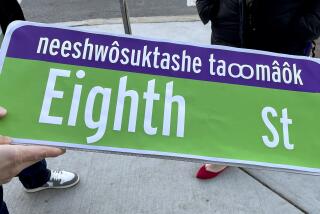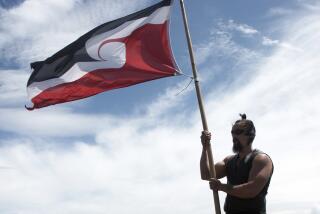Dictionary for Deaf : CSUN Nurtures New Zealand’s Sign Language
- Share via
Comparative sign language may not be the easiest subject to follow, so let’s begin with a simple example:
If you were deaf in America and needed to say the word hooker , as in lady of the night, you would brush the back of your fingers across your cheek lightly in a gesture that would seem to suggest a blush or a bit of embarrassment.
In New Zealand, on the other hand, you’d go right to the heart of the matter, twirling your fist in small circles at shoulder height the way a hooker twirls her pearls.
These tidbits from the lighter side of sign language came up in casual conversation Monday among interpreters for the deaf at California State University, Northridge.
The interpreters had gathered in CSUN’s National Center on Deafness Library for a brief ceremony in which a young woman--one of the first eight New Zealanders trained as interpreters for the deaf--thanked CSUN for its contributions to her country’s nascent program to cultivate its native sign language.
First Dictionary of Its Kind
She gave the library a copy of “Introduction to New Zealand Sign Language,” the first published dictionary of the native language of New Zealand’s 6,000 deaf. The 1,200-sign dictionary was written by Dan Levitt, senior interpreter for the CSUN deafness center, while on a year’s leave of absence in New Zealand.
And, the twirling fist helps to illustrate why a country where most of the people already speak the King’s English would need a separate dictionary of sign language.
For, wherever the deaf are, they develop their own sign language. American Sign Language developed from French and American strains, Levitt said.
New Zealand sign, coming from a British tradition, became a distinct language that had never been formally codified. Since 1880, the country’s educational system had promoted lip reading and phonetic training to teach standard English, with sign language relegated to substandard status.
By 1980, however, the failure of the oral tradition to achieve literacy among the deaf persuaded the New Zealand’s Education Department to try an approach allowing formal instruction in signing.
Levitt was retained to teach the first class in 1985. Levitt, who has since left CSUN to become director of the Self Actualization Institute for the Deaf, in Hollywood, said he found his New Zealand assignment more challenging than he had expected.
Though he had been assured that there was a standard text for New Zealand Sign Language, this turned out to be for the sign language system called Australiasian, a signed representation of English with syntax, conjugations, prefixes and suffixes.
But it was not the language of deaf New Zealanders. Their language was spontaneous and could include a subject, verb and object in a single sign.
Though universal among the deaf over 18, it had been so suppressed, Levitt said, that “many deaf people, upon first meeting, refuse to admit that they even know sign language.”
Drafted 8 Students
Levitt recruited eight students to become the nation’s first interpreters. To teach them a language that he did not yet know himself, he brought the deaf into his class.
“Dan had to ask people to come to the class, sit and talk and tell us stories,” said Rachel Locker, who presented the book to CSUN on Monday. She came to CSUN to enroll in summer classes in sign language theory.
Levitt said he hopes the book will help to make the deaf in New Zealand more comfortable with their native language.
“People do look at the written word as validating a language,” he said. “So we had to do something in writing.”
More to Read
Sign up for Essential California
The most important California stories and recommendations in your inbox every morning.
You may occasionally receive promotional content from the Los Angeles Times.











